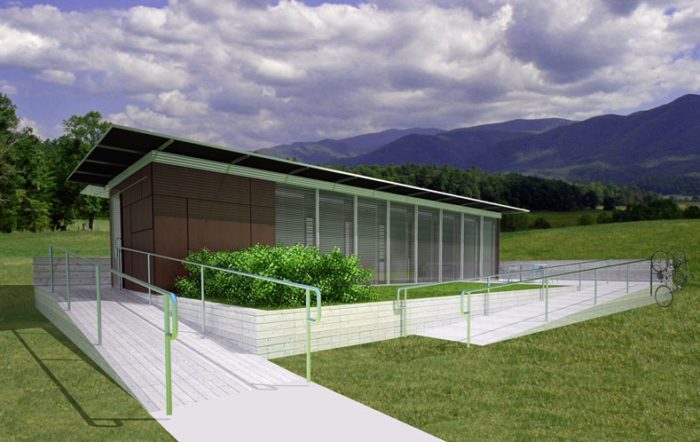
Image Credit: University of Tennessee
Image Credit: University of Tennessee Constructed with a steel frame, Living Light is designed to be fitted with truck-trailer wheels and a gooseneck for towing, so the entire house can be transported easily from one location to another. Living Light’s north and south walls will be mostly glass, a double façade system consisting of an outer, fixed pane of tempered glass set in shock absorbing mounts and an inner plane of triple-glazed windows. Team Tennessee created a series of four renderings to illustrate how Living Light’s programmable system of blinds controls the interior’s exposure to sunlight in the winter. This image shows the interior as the blinds gradually open in the morning. Interior daylighting in the afternoon. The system of black, horizontal blinds is designed to both shade the interior from direct sunlight and collect heat from the sun. The air cavity between the double-façade system exhausts warm air into an energy recovery ventilator, providing preheated air to the home. The interior as the winter sun sets. The interior at night, when the blinds are drawn to provide privacy.
University of Tennessee’s Living Light is among the 2011 Solar Decathlon’s more straightforward expressions of form and function, with heavily glazed north and south walls and a compact, steel-framed rectangular shape that allows it to be lifted onto a set of truck-trailer wheels, coupled to a road tractor, and hauled down the highway like a moving van.
In designing Living Light, its first Decathlon entry, Team Tennessee said it was inspired by Cherokee shelters in East Tennessee and the cantilevered barns of Appalachia, where both winter and summer include challenging weather conditions. But the team also focused on how the home’s simple shape could be exploited to make the most of its passive solar and daylighting potential.
The house is 750 sq. ft. – notably smaller than most homes in the 2011 competition, where the limit on interior space is 1,000 sq. ft. The east and west ends, which contain the mechanical cores, feature R-30 stud walls. The 10.9-kW rooftop array is horizontal, and the white reflective roof under it is nearly so. The array, in this case, uses a copper indium gallium diselenide thin-film absorber wrapped inside cylindrical modules to capture sunlight from all directions.
Live at the International Builder’s Show
Clear, translucent, and layered walls
Living Light’s north and south walls are layered with glazing in unconventional ways. Each wall is actually a double façade: on the outside, a single fixed pane of tempered R-1 glass sits on shock-absorbing mounts; on the inside, R-11.4 triple-pane windows, some of which are operable, sit in wood-veneered aluminum frames. Transparent glass dominates the south façade while translucent glass dominates the north façade, although the operable-window areas on each will be about the same.
One basic aim is to provide abundant daylighting for the structure and maximize passive solar gain when it’s needed in the winter. But the walls actually are as much about shading as they are about flooding the house with light. An automated, horizontal-blind system sandwiched between the inner and outer glass walls controls the amount of light let into the conditioned space. And as the blind slats warm up in the sun, a ventilation fan directs air to an energy-recovery ventilator to harvest the heat. The space between the inner and outer windows also is equipped with hidden electric lights whose automated operation is coordinated with that of the blinds to smooth transitions from daytime to night and back.
MORE INFORMATIONLiving Light Team Web pageDOE Web page for University of TennesseeGBA Resource Guide for 2011 Solar Decathlon
In addition to the energy-recovery ventilator, the HVAC system includes two ductless minisplit heat pumps. Team Tennessee says the house is designed for “young professionals with an average income of $100,000 working in the vibrant design, science, and technology industries of Nashville, Tennessee.” But after the Decathlon, it will hit the road rather than the real estate market, embarking on what the team had dubbed the Tennessee Tour. After that, it will serve as a laboratory for new technologies and collecting performance data.
Weekly Newsletter
Get building science and energy efficiency advice, plus special offers, in your inbox.















One Comment
Really?
“young professionals with an average income of $100,000..."
"750 sqft..."
'black louvers...'
'close at night for privacy...'
'hidden electric lights'
quad-pane (one lite fixed)?
pardon me but my head is spinning...either these guys are brilliant, or...???
So the 'operable' triple-glazed open into the (how wide) air gap? Fresh air via rim-joist level vents, it seems. Corbu tried 'Le Mur Neutralisant'
Black louvers will probably be a contrast-glare nightmare...and using 'harvesting the heat' as an excuse is weak; OrangeMode was doing that from black roofs years ago.
All-glass seems like a privacy nightmare (we've already done this, multiple times...VanDerRohe, Johnson)...and since when do we only want privacy at night?
As for hidden electric lights in the air gap...so what? Controlling the waste heat better? Fine...but you're probably dumping a lot of lumens out of the glass too, aside from what's absorbed by the black louvers...
Finally, I know some folks in Nashville...and they don't make near $100,000 a year. But if they did, I'm pretty sure they wouldn't want to live in a box the size and shape of a truck trailer, when that kind of money could cover a mortgage on something far larger (especially in this market)...
In short...until I see some qualitative (real-world, inhabited building performance numbers and cost data), and some qualitative (user survey) data...I can't imagine this moving us forward any...
Prove me wrong?
David/China
Log in or create an account to post a comment.
Sign up Log in